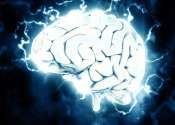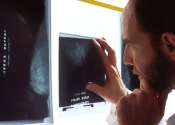Last update:
Radiology & Imaging news
Radiology & Imaging
AI improves mammography cancer detection rates in large cohort study
An observational, multicenter, real-world study conducted at 12 screening sites in Germany has reported a 17.6% higher cancer detection rate among women aged 50–69 who received AI-supported double-reading mammography screenings ...
Jan 8, 2025
0
24
Sleep disorders
Optical imaging technique offers more precise diagnosis of sleep apnea
Obstructive sleep apnea (OSA) is a common sleep disorder characterized by intermittent airway blockages during sleep, leading to disrupted breathing. Despite advances in diagnostic tools, current methods for assessing the ...
Jan 7, 2025
0
0
Decrease seen in in situ breast cancer since 2009
The incidence of in situ breast cancer has decreased since 2009, consistent with decreasing use of mammography in association with the 2009 U.S. Preventive Services Task Force (USPSTF) guideline change, according to a study ...
Jan 6, 2025
0
0

Advanced imaging uncovers hidden metastases in high-risk prostate cancer cases
A study led by researchers at the UCLA Health Jonsson Comprehensive Cancer Center has found that many cases of high-risk nonmetastatic hormone-sensitive prostate cancer may be more advanced than previously thought.
Jan 3, 2025
0
41

Improving predictions about brain cancer outcomes with the right imaging criteria
A paper published in the Journal of Clinical Oncology, titled "Comparative Analysis of Intracranial Response Assessment Criteria in Patients With Melanoma Brain Metastases Treated With Combination Nivolumab + Ipilimumab in ...
Jan 3, 2025
0
0

Non-invasive imaging technique offers insight into Achilles tendon injury recovery
Achilles tendon injuries are common but challenging to monitor during recovery due to the limitations of current imaging techniques.
Jan 3, 2025
0
0

AI-based ultrasound evaluation can improve ovarian cancer diagnoses
A new international study led by researchers at Karolinska Institutet in Sweden shows that AI-based models can outperform human experts at identifying ovarian cancer in ultrasound images. The study is published in Nature ...
Jan 2, 2025
0
22

New 'molecular flashlight' technique detects brain metastases in mice using ultra-thin light probe
Monitoring molecular changes in the brain caused by cancer and other neurological pathologies in a non-invasive way is one of the major challenges in biomedical research. A new experimental technique has achieved this by ...
Dec 31, 2024
0
22

Could AI plus lasers help catch very early breast cancers?
Very early-stage breast cancers are notoriously tough to spot via mammograms, but new technology might make detection easier.
Dec 26, 2024
0
0

New lung scanning method can show treatment effects in real time
A new method of scanning lungs is able to show the effects of treatment on lung function in real time and enable experts to see the functioning of transplanted lungs.
Dec 24, 2024
0
103

New MRI technique identifies heart disease risk from fat composition
Everyone knows the health risks of carrying too much fat around the waist and hips, but UVA Health scientists are developing a noninvasive way to assess the health risks of unseen fat around the heart.
Dec 23, 2024
0
6

Disparities seen in biennial mammography screening for women in their 40s
For women aged 40 to 49 years, there are considerable disparities and gaps in biennial mammography screening, according to a research letter published online Dec. 20 in JAMA Network Open.
Dec 23, 2024
0
0

MRI-first strategy for prostate cancer detection proves deemed safe and effective
There are several strategies for the early detection of prostate cancer. The first step is often a blood test for prostate-specific antigen (PSA). If PSA levels exceed a certain threshold, the next step typically involves ...
Dec 19, 2024
0
2

New microscopy technique could enable rapid tumor analysis in the operating room
Bioengineers at Caltech have developed a new imaging technology that could offer surgeons a fast and cost-effective way to image tissue samples in the operating room to determine whether the entirety of a tumor has been removed ...
Dec 18, 2024
0
38

Single X-ray projection achieves 3D imaging, reducing radiation exposure
Computed tomography (CT) has long been a cornerstone of modern imaging, providing detailed 3D insights into the human body and other materials. However, conventional CT requires hundreds of X-ray projections from multiple ...
Dec 18, 2024
0
21

Novel radiotracer identifies critical cancer biomarker, opens door to new therapeutic target for solid tumors
A new molecular imaging agent can accurately identify a crucial biomarker found among many different types of cancer. Precise visualization of the trophoblast cell surface antigen 2 (Trop2) biomarker can provide physicians ...
Dec 18, 2024
0
0

Scientists develop scans that light up aggressive cancer tumors for better treatment
Researchers have used a chemical compound to light up treatment-resistant cancers on imaging scans, in a breakthrough that could help medical professionals better target and treat cancer.
Dec 17, 2024
0
31

Electronic sepsis screening reduces 90-day in-hospital mortality
Electronic sepsis screening among hospitalized ward patients reduces 90-day in-hospital mortality compared with no screening, according to a study published online Dec. 10 in the Journal of the American Medical Association ...
Dec 17, 2024
0
0

Enhanced dual-mode imaging: New transducer delivers ultrasound and photoacoustic imaging simultaneously
A research team has developed the world's first high-performance photoacoustic endoscopy based on a transparent ultrasonic transducer. Their findings were recently published in the journal Science Advances.
Dec 16, 2024
0
1

'Dancing the blues away' seen in brain imaging in people with Parkinson's disease
Dancing lowers the depression associated with Parkinson's disease, and the benefits can be seen in multiple ways, according to a study involving York University researchers published in the Journal of Medical Internet Research.
Dec 16, 2024
0
0

Study highlights brain-preserving radiation technique for rare cancer
A recent University of Kentucky Markey Cancer Center study highlights a radiation therapy technique that treats brain tumors while preserving patients' cognitive function. The treatment approach could offer hope for patients ...
Dec 16, 2024
0
0

Researchers examine the legal and ethical aspects of AI in radiology
Bart Custers and Eduard Fosch-Villaronga from eLaw–Center for Law and Digital Technologies have contributed a chapter to the volume "AI Implementation in Radiology: Challenges and Opportunities in Clinical Practice."
Dec 16, 2024
0
10

Pioneering MRI method spots pre-malignant pancreatic lesions for the first time
Precursor lesions of pancreatic cancer are very difficult to characterize with magnetic resonance imaging (MRI). But now, in a new study, researchers led by Noam Shemesh and Carlos Bilreiro—respectively, head of the Preclinical ...
Dec 13, 2024
0
2

Mobile mammography boosts screening in underserved communities
A study by the Harvey L. Neiman Health Policy Institute demonstrates that mobile mammography is generally used by women otherwise unlikely to be screened, and thus is complementary to facility-based mammography rather than ...
Dec 13, 2024
0
0

New type of medical scanner shows promise for stroke patients
A new type of medical scanner developed by a University of Aberdeen team has shown that it can identify brain damage in stroke patients at lower magnetic fields than ever before.
Dec 12, 2024
0
30












































